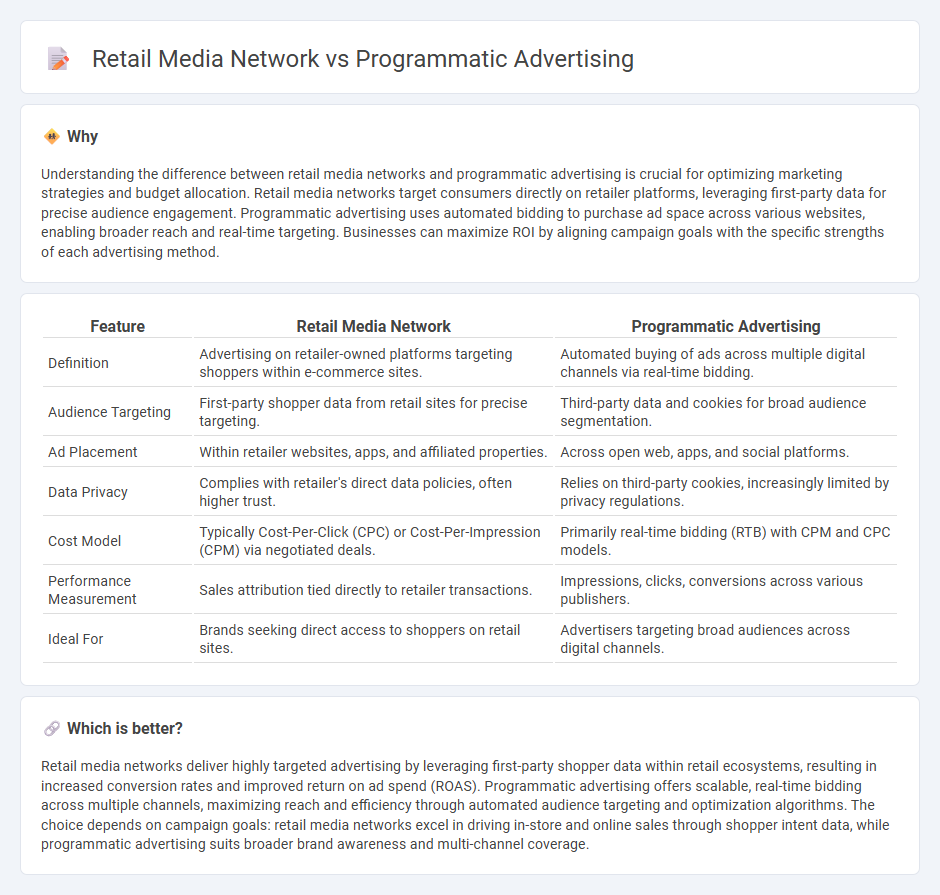
Retail media networks leverage first-party retail data to deliver highly targeted ads directly within e-commerce ecosystems, driving better purchase intent and measurable sales impact. Programmatic advertising automates media buying across diverse digital platforms using real-time bidding, maximizing reach and efficiency through audience segmentation and data-driven optimization. Explore the differences to optimize your marketing strategy in commerce.
Why it is important
Understanding the difference between retail media networks and programmatic advertising is crucial for optimizing marketing strategies and budget allocation. Retail media networks target consumers directly on retailer platforms, leveraging first-party data for precise audience engagement. Programmatic advertising uses automated bidding to purchase ad space across various websites, enabling broader reach and real-time targeting. Businesses can maximize ROI by aligning campaign goals with the specific strengths of each advertising method.
Comparison Table
| Feature | Retail Media Network | Programmatic Advertising |
|---|---|---|
| Definition | Advertising on retailer-owned platforms targeting shoppers within e-commerce sites. | Automated buying of ads across multiple digital channels via real-time bidding. |
| Audience Targeting | First-party shopper data from retail sites for precise targeting. | Third-party data and cookies for broad audience segmentation. |
| Ad Placement | Within retailer websites, apps, and affiliated properties. | Across open web, apps, and social platforms. |
| Data Privacy | Complies with retailer's direct data policies, often higher trust. | Relies on third-party cookies, increasingly limited by privacy regulations. |
| Cost Model | Typically Cost-Per-Click (CPC) or Cost-Per-Impression (CPM) via negotiated deals. | Primarily real-time bidding (RTB) with CPM and CPC models. |
| Performance Measurement | Sales attribution tied directly to retailer transactions. | Impressions, clicks, conversions across various publishers. |
| Ideal For | Brands seeking direct access to shoppers on retail sites. | Advertisers targeting broad audiences across digital channels. |
Which is better?
Retail media networks deliver highly targeted advertising by leveraging first-party shopper data within retail ecosystems, resulting in increased conversion rates and improved return on ad spend (ROAS). Programmatic advertising offers scalable, real-time bidding across multiple channels, maximizing reach and efficiency through automated audience targeting and optimization algorithms. The choice depends on campaign goals: retail media networks excel in driving in-store and online sales through shopper intent data, while programmatic advertising suits broader brand awareness and multi-channel coverage.
Connection
Retail media networks leverage first-party shopper data to deliver highly targeted ads within e-commerce platforms, enhancing programmatic advertising efficiency by automating real-time ad buying and placements. This integration allows brands to optimize ad spend through precise audience segmentation and measurable ROI, driving increased sales directly at the point of purchase. Programmatic technology powers data-driven decision-making in retail media, creating seamless consumer experiences and maximizing advertising impact.
Key Terms
Real-Time Bidding (RTB)
Real-Time Bidding (RTB) enables programmatic advertising by allowing advertisers to bid on individual ad impressions in real-time across various platforms, maximizing reach and targeting precision. Retail media networks leverage RTB within their proprietary ecosystems, focusing on first-party data to deliver highly relevant ads to shoppers on retail sites, enhancing conversion rates and ROI. Explore how integrating RTB within retail media networks can transform your advertising strategy and drive sales growth.
First-Party Data
Programmatic advertising leverages diverse third-party data sources for targeted campaigns, whereas retail media networks capitalize on rich first-party data collected directly from in-store and online consumer interactions. First-party data in retail media networks enhances precision targeting and personalized ad experiences by utilizing purchase history, loyalty programs, and browsing behaviors unique to the retailer's ecosystem. Explore how integrating first-party data transforms ad effectiveness and drives higher ROI in both programmatic and retail media strategies.
Walled Garden
Programmatic advertising leverages automated bidding and real-time data across open web inventory, contrasting with retail media networks that operate within walled gardens, using proprietary first-party shopper data for targeted ads on retail platforms. Walled gardens in retail media networks provide advertisers with exclusive access to high-intent consumer segments and detailed purchase insights, enhancing ad relevance and ROI. Explore how the walled garden advantage shapes advertising strategies and drives measurable outcomes.
Source and External Links
What is programmatic advertising? - Programmatic advertising is the automated buying and selling of ad space using AI and real-time bidding in a virtual auction, making the ad-buying process faster and more efficient.
Programmatic Advertising - What It Is and How It Works - It uses marketing technology and automation to purchase digital ad inventory instantly across web, mobile, video, and social channels, targeting audiences based on data signals like shopping patterns.
What Is Programmatic Advertising? How Does It Work? - Programmatic advertising automates media buying using algorithms and user data to place ads precisely, ensuring ads reach the right audience in the right context without manual negotiation.
 dowidth.com
dowidth.com